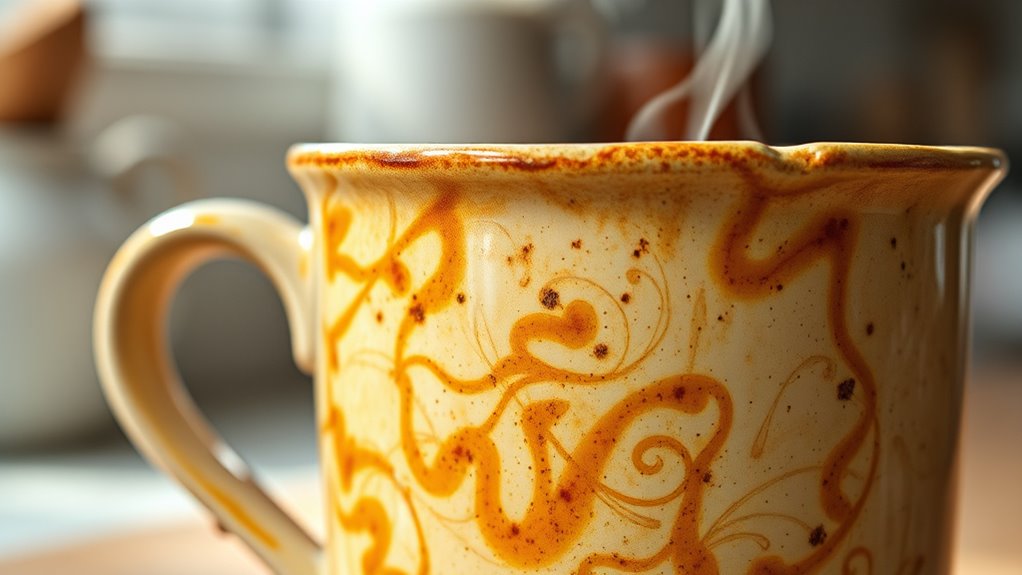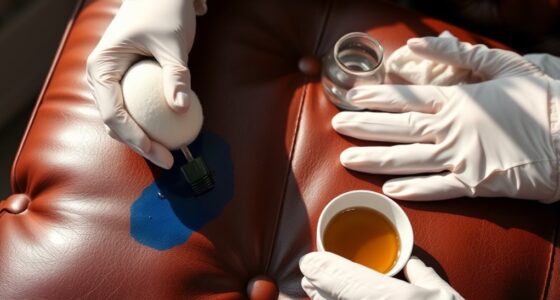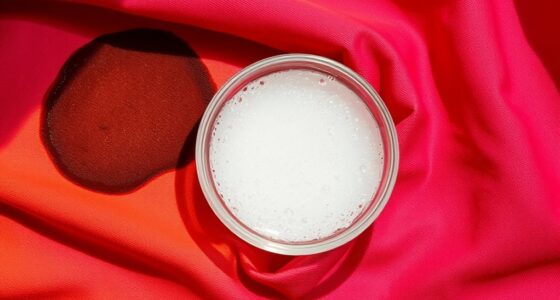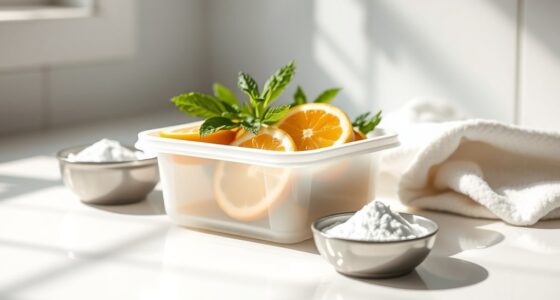Tea stains can quickly mar your favorite mug, but you can easily restore its beauty. Try a baking soda paste or soak it in a vinegar solution to lift those stubborn stains. Adding milk to your tea can help prevent future discoloration. For maintenance, rinse your mugs right after use and consider specialized cleaning tools for tough stains. There are plenty of effective ways to tackle these stains, and you’ll discover even more helpful tips ahead.
Key Takeaways
- Use a baking soda paste, applying it to stains for 10 minutes before scrubbing gently to lift tea marks effectively.
- Soak your mug in equal parts white vinegar and water for 30 minutes to help dissolve stubborn tea stains.
- Fresh lemon juice can be applied directly to stains; let it sit for 10-15 minutes before rinsing.
- Regularly clean mugs with enzyme-based stain removers and avoid overcrowding during storage to maintain cleanliness.
- For persistent stains on valuable mugs, consider professional cleaning to ensure they are treated with care and expertise.
Understanding Tea Stains

Tea stains on your mugs can be a pesky reminder of your favorite beverage, mainly caused by tannins, which are natural compounds found in tea. These polyphenols not only offer health benefits but also leave behind that stubborn brown residue. Additionally, the traditional tea ceremony emphasizes the importance of serving tea in a clean vessel, reflecting the respect for the beverage and the experience.
When tannins interact with calcium in hard water, they form insoluble deposits that cling to your mug. The type of tea you choose matters too; black tea has higher tannin content, increasing the likelihood of stains. Notably, adding milk can help prevent staining, as the proteins bind with tannins and reduce their staining ability. Natural aging occurs through oxidization from exposure to elements, and this can also be a factor in how your mug retains those tea stains. So, if you want to keep your mug looking fresh, consider your tea choices and how hard your water is.
Natural Stain Removal Techniques
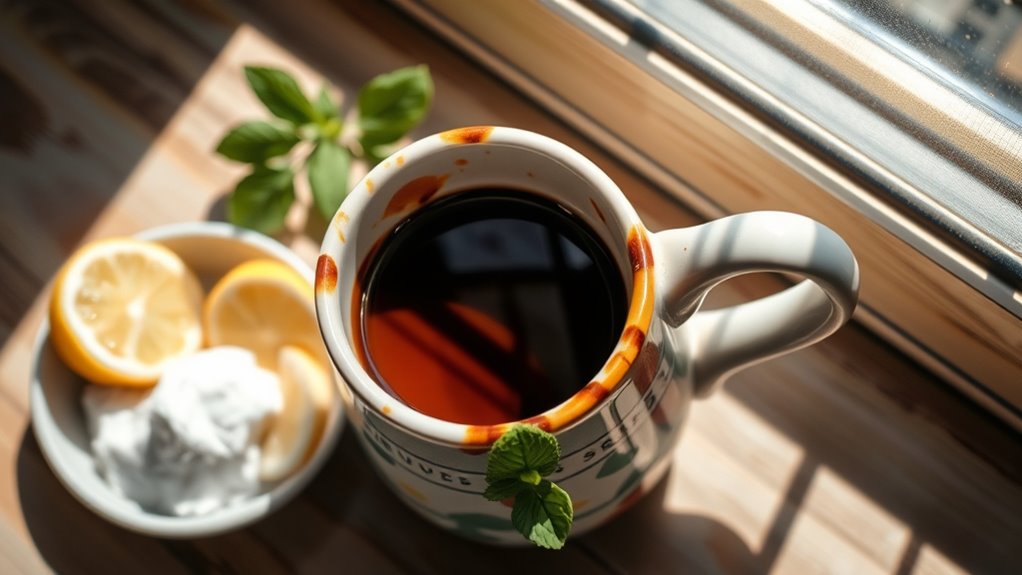
Stains on your favorite mugs don’t have to be a permanent issue. You can easily tackle them using natural techniques.
For instance, mix one tablespoon of baking soda with water to create a paste, apply it to the stain, let it sit for 10 minutes, then scrub and rinse. Baking soda can also be used on damp tea stains; leave it overnight for best results.
Alternatively, soak the mug in equal parts white vinegar and water for about 30 minutes before rinsing.
If you prefer a citrusy touch, squeeze fresh lemon juice directly onto the stain, allowing it to sit for 10-15 minutes before scrubbing.
You can also mix salt with vinegar or water to lift the stain effectively.
With these methods, your mugs can look as good as new without harsh chemicals.
Preventing Future Stains

To keep your mugs looking pristine, it’s essential to adopt some preventive measures right from the start. Choose mugs made from stain-resistant materials and use mild, non-abrasive dish soap to minimize scratches. If possible, use soft water, as it reduces calcium that can react with tannins. Rinse your mug immediately after use to stop stains from setting, and avoid placing it on uneven surfaces that cause heat spots. When enjoying tea, consider adding milk; its proteins bind with tannins, greatly lowering the risk of stains. Additionally, regular cleaning with enzyme-based stain removers can help prevent the buildup of tea stains over time. Hand wash your mugs and store them properly to prevent dust accumulation. By establishing these habits, you’ll maintain your mugs’ appearance and enjoy your tea without the worry of unsightly stains.
Common Cleaning Methods

When it comes to keeping your mugs looking their best, knowing the right cleaning methods is essential. You can start with natural ingredients like vinegar, which dissolves stains when soaked in a water-vinegar mix. Baking soda can also help; just make a paste and scrub gently. For a fresh twist, try lemon juice mixed with salt, using the lemon half to scrub away stains. Non-gel toothpaste is another option; apply it and scrub with an old toothbrush. Remember that regular cleaning can prevent buildup of stains over time. Additionally, utilizing various brewing methods can help you choose drinks that create fewer stains on your favorite mugs. If you prefer household cleaners, dish soap combined with water works well, as color accuracy in cleaning can enhance the overall appearance of your mugs. It’s important to note that regular filter maintenance can improve air quality, which may minimize staining from beverages. Keeping your cleaning routine consistent supports a healthier lifestyle by promoting cleanliness. Hydrogen peroxide is great for light-colored mugs, while club soda can help lift stains due to its carbonation. Don’t forget to scrub gently with a non-abrasive sponge for best results!
Specialized Cleaning Tools

If you’re serious about tackling tea stains on your mugs, specialized cleaning tools can make a significant difference. A baking soda scrubber gently removes stains without harsh chemicals, while Milton sterilizing fluid is great for soaking away stubborn marks.
For tough spots, try Dip-It XP or Oxyclean; both are formulated to lift those persistent tea stains effectively. Regularly cleaning your mugs can help prevent stain accumulation over time, making maintenance easier. Don’t forget a toothbrush for detailing—it’s perfect for scrubbing hard-to-reach areas. Additionally, using baking soda as a mild abrasive can help scrub off those tough stains effectively.
Interestingly, herbal teas like chamomile and ginger can also contribute to stain formation due to their natural pigments. Using portable camping toilets while on outdoor adventures can also encourage you to keep your beverage mugs cleaner, as they provide a convenient way to dispose of tea without messy accidents. Moreover, incorporating fresh ingredients in your drinks can enhance flavor and potentially reduce staining, giving you a dual benefit while enjoying your favorite beverages. These tools and solutions guarantee your favorite mugs stay clean and stain-free, enhancing your tea-drinking experience with every sip!
Materials Affected by Tea Stains

Tea stains can affect a variety of materials, making it essential to know which surfaces are most vulnerable. Fabric is especially prone to staining due to tannins that bond quickly with fibers. If you spill tea, act fast to prevent the stain from setting, as darker teas like black tea can leave more pronounced marks. Tea stains are difficult to remove because the tannins act as natural dyes that bond quickly with fabric fibers. Stainless steel mightn’t get stained by tea itself, but it can show cosmetic corrosion in coastal areas. Porcelain and ceramic can also stain, especially with hard water. Adding milk can help bind tannins and reduce staining. Other materials like wood, bamboo, and glass can show tea stains too, but regular cleaning can help prevent this issue.
Tips for Maintaining Your Mugs
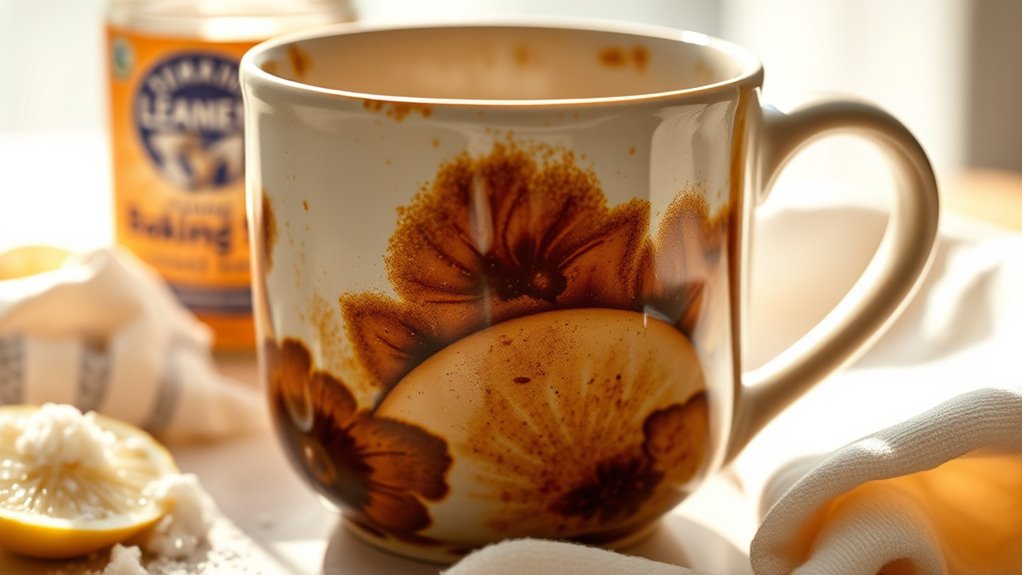
Maintaining your mugs can extend their lifespan and keep them looking great for years. Rinse your ceramic mugs with warm water right after use to stop tea stains from setting. Use a soft sponge and mild detergent for cleaning; avoid abrasive cleaners that can scratch the surface. Handle mugs gently to prevent cracks from sudden temperature changes. Regularly inspect your mugs for any chips or wear. Maintaining ceramic mugs ensures hygiene and safety for use, so it’s essential to adhere to these maintenance practices. When storing, keep mugs upright and avoid overcrowding to prevent damage. For deep cleaning, create a baking soda paste for stains, and soak stubborn odors in a vinegar solution. Always air-dry mugs completely to prevent moisture-related issues. Follow these tips, and your mugs will stay in excellent condition for longer!
When to Seek Professional Help
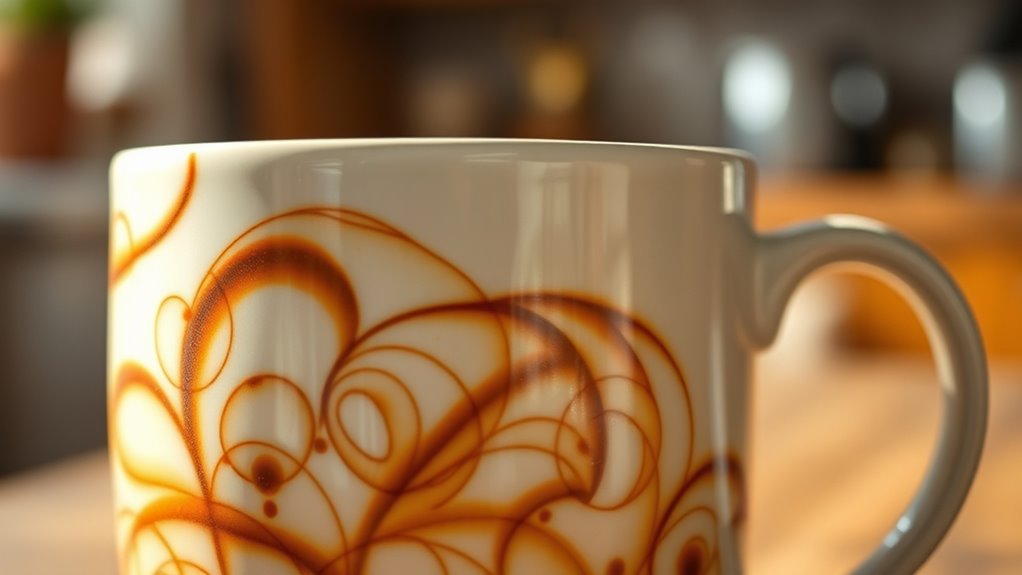
When stubborn tea stains refuse to budge despite your best DIY efforts, it might be time to contemplate professional help.
If you’ve tried everything and the stains are still there, consider enlisting experts. This is especially true for rare or fragile mugs that need specialized care. Prompt washing helps maintain the quality of your mugs, so if stains persist, it’s essential to act quickly. Weigh the cost of cleaning against replacing the mug; sometimes, preservation is worth it. If you frequently clean multiple mugs, professional services can save you time.
For antiques or collectibles, a specialized cleaning service guarantees they’re treated with the necessary care.
Frequently Asked Questions
Can Tea Stains Affect the Taste of My Beverage?
Yes, tea stains can affect the taste of your beverage. Tannins in the tea can cling to the mug, especially if it’s porous, and transfer their flavor into your drink.
If you’ve got a buildup of stains, they might alter the taste profile of your tea, making it less enjoyable. Regularly cleaning your mug helps maintain the pure flavor of your favorite brews, ensuring each sip is as delightful as it should be.
Are There Specific Teas That Stain More Than Others?
Yes, some teas do stain more than others.
Black tea, with its high tannin and chromogen content, is the most notorious for leaving stubborn stains. Oolong tea also has a moderate staining potential due to partial oxidation.
In contrast, green tea tends to leave less of a mark, while white tea causes minimal staining.
If you’re concerned about stains, consider opting for lighter teas or using a different type of cup.
How Often Should I Clean My Mugs to Prevent Stains?
You should clean your mugs regularly to prevent stains.
If you use them daily, wash them after each use. For occasional use, aim to clean them at least once a week.
Mugs made of porous materials, like ceramic, need more frequent attention to avoid buildup. Rinsing right after use can help, and consider deep cleaning every week or two to maintain hygiene and keep your mugs looking their best.
Is It Safe to Use Bleach on Tea-Stained Mugs?
It’s generally not safe to use bleach on tea-stained mugs.
Bleach can weaken the mug’s finish, making stains harder to remove over time. Instead of risking damage, consider safer alternatives like baking soda paste or a vinegar and salt solution.
If you must use bleach, always dilute it and test a small area first.
Can I Use Natural Remedies on Colored or Decorated Mugs?
Did you know that 85% of people face stubborn stains on their favorite mugs?
You can absolutely use natural remedies on colored or decorated mugs! Ingredients like lemon juice and vinegar safely dissolve stains without damaging the surface.
Baking soda’s gentle abrasiveness works wonders, too. Just test a small area first, and remember to rinse thoroughly afterward.
With these methods, your mugs can look fresh and vibrant again, maintaining their charm for years to come!
Conclusion
Your favorite mug, much like cherished memories, deserves to shine bright without the shadow of tea stains. By embracing natural cleaning methods and practicing preventive care, you can restore its beauty and guarantee it holds many more moments of warmth. Remember, just as life’s little messes can be wiped away, so can the stubborn reminders of past brews. Keep your mug a symbol of comfort and joy, and let it serve as a reminder to cherish every sip.
